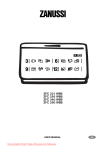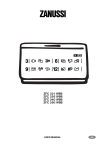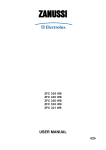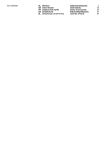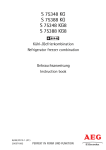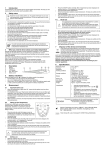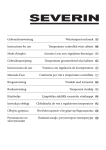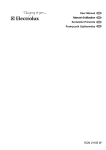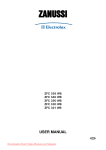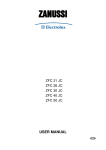Download Zanussi ZFC 50 User manual
Transcript
ZANUSSI ZFC 50 JB Gebrauchsanleitung Εγχειρίδιο οδηγιών του χρήστη User Manual Manuel d'utilisation DE EL EN FR DE Entsorgung Sie tragen mit der Sicherstellung der korrekten Entsorgung des Produkts dazu bei, potentielle Schäden für die Umwelt und menschliche Gesundheit zu vermeiden. Das Symbol auf dem Produkt deutet darauf hin, dass dieses Produkt nicht als Hausmüll behandelt werden darf, sondern einer geeigneten Sammelstelle für das Recycling von elektrischen und elektronischen Geräten zugeführt werden muss. Eine genauere Auskunft über das Recycling dieses Produkts erhalten Sie von Ihrem zuständigen Stadtamt, Ihrem kommunalen Abfallwirtschaftsbetrieb oder Ihrem Fachhändler, wo Sie das Gerät gekauft haben. Sicherheitshinweise Bevor Sie aber das Gerät aufstellen und benutzen, sollten Sie diese Gebrauchsanweisung aufmerksam durchlesen. Sie enthält Sicherheitsmaßnahmen, Hinweise, Informationen und Ideen. Wenn das Gerät nach den hier beschriebenen Anweisungen benutzt wird, wird es zu Ihrer größten Zufriedenheit einwandfrei funktionieren. Diese Hinweise dienen Ihrer Sicherheit. Sie müssen diese aufmerksam durchlesen, bevor Sie das Kühlgerät aufstellen oder benutzen. Benutzen Sie das Gefriergerät nur zur Lagerung von eingefrorenen Lebensmitteln, zum Einfrieren von frischen Lebensmitteln und zur Zubereitung von Eiswürfeln. Nehmen Sie Eiswürfel oder Speiseeis sofort nach der Entnahme aus dem Gefriergerät nicht gleich in den Mund, weil diese Frostbrand verursachen können. Gestatten Sie den Kindern nicht, im Inneren des Gefriergeräts zu spielen oder sich dort zu verbergen, weil sie daraus möglicherweise nicht herauskommen und ersticken könnten. Bewahren Sie keine Glasbehälter mit Flüssigkeit im Gefriergerät auf, weil der Glasbehälter platzen kann. Sorgen Sie dafür, dass das Gefriergerät nicht auf dem Stromkabel aufgestellt wird. Vor der Instandhaltung oder Reinigung muss das Gerät vom Stromnetz getrennt werden (Netzstecker aus der Steckdose ziehen). Im Inneren des Geräts dürfen keine Elektrogeräte (z.B. Eismacher) betrieben werden. In Ihrem Gefriergerät kommt ein umweltfreundliches Gas - Isobutan -R600a) - zur Anwendung. Allerdings ist Vorsicht geboten, weil Isobutan entzündlich ist. Daher ist es wichtig, dafür zu sorgen, dass die Rohrleitung des Kühlmittels nicht beschädigt ist. Diese Gebrauchsanweisung sollte auf einem sicheren Ort aufbewahrt werden, damit sie in Zukunft jederzeit zum Nachschlagen bereitsteht. Produktbeschreibung 1. 2. 3. 4. 5. 6. 7. 8. Deckelgriff Sicherheitsschloss Dichtung Schmelzwasserabfluss Schalttafel Thermostatknopf: Temperatureinstellung Oberkante Licht Schalttafel A. Rotes Licht: Leuchtet, wenn die Temperatur im Gefriergerät nicht tief genug ist. B. Grünes Licht: Leuchtet, wenn das Gerät eingeschaltet ist. C. Gelbes Licht: Leuchtet, wenn die Super Freeze Funktion eingeschaltet ist. D. Super Freeze Knopf: Schaltet die Super Freeze Funktion für größere Mengen an frischen Lebensmitteln ein und aus und schaltet die Alarmglocke aus. Aufstellung Warten Sie nach dem Auspacken mindestens 2 Stunden, bevor Sie das Gefriergerät an das Stromnetz anschließen, um sicherzustellen, dass der Kühlmittelkreis einwandfrei arbeitet. Stellen Sie das Gefriergerät in einem trockenen, gut belüfteten Raum auf. Meiden Sie bei der Auswahl des Aufstellungsortes die Nähe von Wärmequellen oder direkte Sonnenbestrahlung. 2 DE Die Raumtemperatur sollte der Klimaklasse entsprechen, für die das Gefriergerät ausgelegt ist (siehe Kapitel "Technische Daten"). Stellen Sie das Gefriergerät waagrecht auf eine feste Oberfläche so auf, dass das Gerät auf allen vier Füssen steht. Für den optimalen Betrieb und zur Vermeidung von Schäden bei der Öffnung des Deckels muss ein Abstand von jeweils 5 cm von den angrenzenden Wandflächen freigelassen werden. Bevor Sie das Gefriergerät an die Stromversorgung anschließen, prüfen Sie, ob die Netzspannung und die Spannungsangabe im Kapitel "Technische Daten" unter "Spannung" übereinstimmen. Gefahr! Achten Sie darauf, dass das Gefriergerät nicht auf dem Stromkabel steht. Auf keinen Fall am Netzkabel ziehen, wenn das Gefriergerät aus einer Ecke herausgenommen werden soll. Das Netzkabel darf nur durch qualifiziertes Personal eines Fachreparaturbetriebs ausgewechselt werden. Sorgen Sie dafür, dass der Netzstecker nicht durch die Rückwand des Gefriergeräts zusammengedrückt oder beschädigt wird. Sorgen Sie für ausreichende Belüftung in der Umgebung des Geräts. Elektrische Arbeiten zur Aufstellung dieses Geräts dürfen nur durch einen qualifizierten Elektriker ausgeführt werden. Achtung! Dieses Gerät muss geerdet werden. Erste Benutzung Vor dem ersten Gebrauch muss das Innere des Kühlgeräts erst gereinigt werden (siehe Kapitel "Reinigung und Pflege"). Schließen Sie das Kühlgerät an das Stromnetz an. Das grüne Kontrolllicht leuchtet auf. Das rote Kontrolllicht leuchtet ebenfalls auf und die Alarmglocke ertönt, weil die Temperatur im Inneren des Kühlgeräts für die Einlagerung von Lebensmitteln nicht tief genug ist. Drücken Sie den Knopf D und schalten Sie damit die Alarmglocke aus. Das rote Kontrolllicht erlischt im Normalfall erst nach einigen Stunden. Lagern Sie erst dann Lebensmittel in das Gefriergerät ein, wenn das rote Kontrolllicht erloschen ist. Ein-/Ausschalten Schalten Sie das Gefriergerät ein Drehen Sie den Thermostatendrehknopf in eine Stellung zwischen und . Schalten Sie das Gefriergerät aus Drehen Sie den Thermostatendrehknopf in die Aus-Stellung. Tägliche Benutzung Temperatureinstellung Die Temperatur des Gefriergeräts wird wie folgt eingestellt: Um eine kältere Lagertemperatur einzustellen, drehen Sie den Thermostaten-Drehknopf im Uhrzeigersinn in Richtung . Um eine weniger kalte Lagertemperatur einzustellen, drehen Sie den Thermostaten-Drehknopf entgegen dem Uhrzeigersinn in Richtung . Super Freeze Funktion Wenn mehr als 3-4 kg frisches Fleisch eingefroren werden soll, muss das Gefriergerät vorgekühlt werden. Drücken Sie den Knopf (D) mindestens 24 Stunden vor der Einlagerung von frischen Lebensmitteln. Das gelbe Kontrolllicht leuchtet auf. Lagern Sie die einzufrierenden Speisen in das Kühlgerät ein. Nach 52 Stunden schaltet sich diese Funktion automatisch aus und das Gerät kehrt zur normalen Lagerungstemperatur zurück. Durch wiederholtes Drücken auf den Knopf (D) kann diese Funktion jederzeit ausgeschaltet werden. Alarm Wenn die Temperatur des Gefriergeräts nicht tief genug ist, ertönt die Alarmglocke und das rote Kontrolllicht leuchtet auf. Zur Ausschaltung des Tonsignals drücken Sie bitte auf Knopf (D). Die rote Kontrollleuchte leuchtet solange, bis die Temperatur im Gefriergerät höher als die Temperatureinstellung des Thermostaten ist. Ursachen des Alarms: Einlagerung von größeren Mengen von frischen Lebensmitteln. Öffnung des Gerätedeckels für längere Zeit. Fehlermeldung des Systems, siehe Kapitel "Was ist zu tun, wenn...". Lagerkörbe Hängen Sie die Körbe auf die Oberkante (X) oder stellen Sie die stapelbaren Körbe in das Gefriergerät (Y). Drehen Sie und arretieren Sie die Griffe für diese zwei Positionen wie abgebildet. 3 DE Zusätzliche Körbe sind bei Ihrem örtlichen Vertragshändler erhältlich oder können auf der Website von Electrolux bestellt werden (je nach Land unterschiedlich). Die Illustrationen auf dieser Seite zeigen, wie viele Körbe in die verschiedenen Gefriergeräte passen. Öffnen und Schließen des Deckels Der Deckel des Geräts ist mit einer dicht schließender Dichtung ausgerüstet und wird sofort nach einer Schließung keine Wiederöffnung zulassen. Warten Sie einige Minuten, bis sich der Deckel wieder öffnen lässt. Der Griff darf nicht mit Gewalt angezogen werden. Reinigung und Pflege Abtauen des Gefriergeräts Wenn die Eisschicht eine Stärke von 10-15 mm erreicht hat, muss das Gefriergerät abgetaut werden. Wir empfehlen Ihnen, das Abtauen dann vorzunehmen, wenn im Gefriergerät wenig oder keine Lebensmittel gelagert werden. Trennen Sie das Gerät vom Stromnetz. Entleeren Sie den Inhalt des Gefriergeräts, packen Sie das Gefriergut in Zeitungspapier und bewahren Sie es an einem kalten Ort auf. Lassen Sie den Deckel des Geräts offen. Nehmen Sie den Stopfen für die Schmelzwasserableitung heraus. Das Schmelzwasser kann auf einem Tablett (siehe Abbildung) aufgefangen werden. Falls Ihr Gerät damit ausgerüstet ist, verwenden Sie dazu bitte den Teiler. Den Abtauvorgang können Sie beschleunigten, indem Sie mit Hilfe des mitgelieferten Schabers das Eis von den Gerätewänden abziehen. Lassen Sie die Innenflächen des Gerätes gründlich trocknen. Vergessen Sie nicht, den Stopfen für die Schmelzwasserableitung wieder einzusetzen. Wichtig! Messer oder andere spitze Gegenstände dürfen nicht zur Entfernung von Eis oder Reif verwendet werden. Reinigung Am günstigsten ist es, die Reinigung des Gefriergeräts nach dem Abtauen vorzunehmen. Trennen Sie das Gerät vom Stromnetz und entfernen Sie daraus alle nicht fest eingebauten Teile. Für die Reinigung des Gefriergeräts verwenden Sie bitte einen nassen Tuch. Verwenden Sie dabei warmes Wasser und ein mildes, nicht aromatisiertes Reinigungsmittel. Vor dem Wiedereinsetzen säubern Sie die nicht fest eingebauten Teile. Wichtig! Verwenden Sie bitte für die Reinigung Ihres Gefriergeräts niemals starke Reinigungsmittel, Scheuerpulver oder Reinigungsmittel mit Duftaroma. Wenn das Gerät nicht benutzt wird Trennen Sie das Gerät vom Stromnetz. Nehmen Sie alle Lebensmittel aus dem Gefriergerät heraus. Reinigen Sie das Gefriergerät wie oben beschrieben. Lassen Sie den Deckel einen Spalt offen. Ersetzen der Glühbirne Trennen Sie das Gerät vom Stromnetz. Schrauben Sie die defekte Glühbirne heraus und setzen Sie eine neue Glühbirne (max. 15W) ein. Schließen Sie das Gerät wieder an das Stromnetz an. Nützliche Hinweise und Tipps Einfrieren von Lebensmitteln Vor dem Einfrieren müssen frische Lebensmittel luftdicht und feuchtigkeitsabsperrend verpackt werden, um eine Austrocknung zu vermeiden. Verwenden Sie immer einwandfreie Lebensmittel bester Qualität. Vor der Einlagerung von warmen Speisen in das Gefriergerät müssen diese erst auf Zimmertemperatur abgekühlt werden. Teilen Sie die Lebensmittel vor dem Einfrieren in kleinere Portionen auf. Damit wird erreicht, dass der Gefriervorgang schneller abläuft und nur die zum sofortigen Verzehr benötigte Mengen an Lebensmitteln aufgetaut werden. Tragen Sie auf die Verpackung der einzufrierenden Lebensmittel das Datum des Einfrierens auf. Stellen Sie frische, einzufrierende Lebensmittel möglichst nahe zu den kältesten Seiten des Gefriergeräts ab und sorgen Sie dafür, dass diese nicht in direkte Berührung mit den bereits gefrorenen Lebensmittel im Gefriergerät kommen. Gefrorene Lebensmittel können überall im Gefriergerät gelagert werden, müssen aber mindestens 5 mm unterhalb der Oberkante gehalten werden. 4 DE Wenn der Gefriervorgang zu langsam verläuft, leidet darunter die Qualität der einzufrierenden Lebensmittel. Die Menge (in kg) an frischen Lebensmitteln, die in 24 Stunden eingefroren werden können, wird im Kapitel "Technische Daten" unter "Gefrierkapazität" angegeben. Lebensmittellagerung Für frisch eingefrorene Lebensmittel: die Lagerungszeit entnehmen Sie bitte der untenstehenden Tabelle. Für Lebensmittel, die im tiefgekühlten Zustand gekauft wurden: beachten Sie bitte die angegebenen Verfallszeiten. Wenn Sie tiefgekühlte Lebensmittel einkaufen, achten Sie stets darauf, ob diese bei der richtigen Temperatur gelagert worden sind. Kaufen Sie keine Ware, die eine nasse oder verletzte Verpackung aufweist. Verstauen Sie die gekaufte Tiefkühlware so schnell wie möglich in Ihrem Gefriergerät. Wir empfehlen Ihnen, eine Isolierkühltasche für den Transport der Ware nach Hause zu verwenden. Wichtig! Beachten Sie bitte, dass völlig oder teilweise aufgetaute Lebensmittel nicht wieder eingefroren werden dürfen. Allerdings dürfen Speisen, die durch Kochen aus aufgetauten Lebensmitteln zubereitet wurden, eingefroren werden. Bei Stromsperre oder Ausfall des Gefriergeräts Öffnen Sie bitte nicht den Deckel. Wichtig! Wenn die Stromsperre die im Kapitel "Technische Daten" unter "Haltbarkeitsdauer" angegebenen Werte übersteigt, müssen die aufgetauten Lebensmittel schnell verzehrt oder sofort gekocht und (nach Abkühlung) wieder eingefroren werden. Was ist zu tun, wenn... Um bei einer möglichen Betriebsstörung die Kosten eines unnötigen Besuchs in der Fachwerkstatt zu vermeiden, versuchen Sie zunächst die nachfolgenden Tipps anzuwenden: Ihr Gefriergerät arbeitet nicht Ist das Gerät an das Stromnetz angeschlossen? Ist eine Haushaltssicherung durchgebrannt? Gibt es eine Stromsperre? Ist der Temperaturregler auf die Position AUS gestellt? Der Alarmton ertönt weiter und/oder das rote Licht/Symbol ( ) leuchtet Ist der Deckel nicht ganz geschlossen? Siehe weiter unten. Ist der Temperaturregler den Umgebungsbedingungen gerecht eingestellt? Wurde das Gefriergerät zu nahe an einer Wärmequelle aufgestellt? Das Innenlicht geht nicht an Ist das Gerät an das Stromnetz angeschlossen? Hat sich die Glühbirne in ihrer Fassung gelockert oder ist sie ausgebrannt? Der Motor scheint zu viel zu laufen Ist der Deckel nicht ganz geschlossen? Siehe weiter unten. Ist die Raumtemperatur höher als üblich? Wurde gerade eine größere Menge frischer Lebensmittel in das Gefriergerät eingelagert? Wird der Deckel zu oft geöffnet? Ist der Temperaturregler den Umgebungsbedingungen gerecht eingestellt? Ist die Deckeldichtung beschädigt oder deformiert? Gibt es ausreichenden Raum für die Luftzirkulation um das Gefriergerät herum? Wurde die Super Freeze Funktion versehentlich eingeschaltet? Temperatur ist zu hoch Wurde gerade eine größere Menge von Lebensmitteln in das Gefriergerät eingelagert? Wird der Deckel zu oft geöffnet? Ist der Temperaturregler den Umgebungsbedingungen gerecht eingestellt? Zu viel Eis wurde gebildet Ist der Deckel nicht ganz geschlossen? Siehe weiter unten. Wurde der Schmelzwasserabflussstopfen richtig eingesteckt? Der Deckel schließt nicht ganz Gibt es zu viel Eis oder eine Verpackung, die den Deckel an einer korrekten Schließung behindern? Gibt es Lebensmittelverpackungen, die den Deckel blockieren? Ist die Deckeldichtung verschmutzt oder verklebt? Gibt es eine Zitterbewegung am Gefriergerät oder scheint das Gerät unstabil aufgestellt zu sein? Der Deckel lässt sich schwer öffnen Ist die Deckeldichtung verschmutzt oder verklebt? Wenn Sie weitere Hilfe benötigen, wenden Sie sich bitte an Ihre örtliche Vertragswerkstatt. Kundendienst und Reparaturen Im Falle eines Ausfalls oder Fehlbetriebs muss Ihr Gefriergerät durch eine Electrolux Vertragswerkstatt repariert werden. Wichtig! Unter keinen Umständen sollten Sie versuchen, das Gerät selbst zu reparieren. 5 DE Technische Daten Modell Volumen (brutto) Volumen (netto) Höhe Breite Tiefe Gewicht Energieverbrauch in 24 Stunden Gefrierkapazität Gefrierhaltezeit Nennleistung Spannung Klimaklasse Klimaklassen SN N ST T l l cm cm cm kg kWh/24 h kg/24 h Stunden W V BNI525 ZFC50JB 500 495 87,6 160 66,5 66 1,338 20 31 125 230 SN-T Umgebungstemperaturgrenzen von +10°C bis +32°C von +16°C bis +32°C von +18°C bis +38°C von +18°C bis +43°C Dieses Gerät erfüllt die Auflagen folgender EG-Richtlinien: 73/23/EWG vom 19. 02. 1973 (Richtlinie über Niederspannungen) 89/336/EWG vom 03. 05. 1989 (einschließlich Änderungsrichtlinie 92/31/EWG EMV-Richtlinie) 6 EL Τοποθέτηση απορριµµάτων και σκουπιδιών Η συσκευή αυτή µε την τοποθέτηση ανάµεσα στα κατάλληλα απορριµµ άτων και σκουπιδιών αποφεύγει τις επιδράσεις και αποτελέσµατα που κατα στρέφουν το περιβάλλον και βλάπτουν την υγεία. Το σύµβολο k31 παρουσιάζει ότι δεν διαχειρί ζεται ως απόρριµµα, πρέπει να µεταφερθεί σε κατάλληλους τόπους και χώρου ς απόρριψης όπου συγκεντρώνουν τα ηλεκτρικά και ηλεκτρονικά µηχανήµατ α και ανταλλακτικά. Πληροφορίες για την ανακύκλωση των απορριµµάτων του προϊόντος µπορείτε να ζητήσετε από τις δηµοτικές αρχές, τις ντόπιες δηµό σιες αρχές καθαριότητας ή το µαγαζί όπου αγοράσατε την συσκευή. Οδηγίες ασφάλειας Πριν από την εγκατάσταση και χρήση της συσκευής διαβάστε προσεχ τικά το εγχειρίδιο οδηγιών του χρήστη. Περιλαµβάνει οδηγίες ασφάλειας, σ υµβουλές, πληροφορίες και ιδέες. Εάν ο καταψύκτης χρησιµοποιείται σύµφω να µε τις οδηγίες του εγχειριδίου, θα λειτουργεί κανονικά και θα σας παρέ χει µεγαλύτερη ικανοποίηση. Προειδοποιήσεις που αφορούν την προσωπική σας ασφάλεια. Πριν από την εγκ ατάσταση και χρήση της συσκευής διαβάστε τις προσεχτικά. Χρησιµοποιείστε τον καταψύκτη µόνο για αποθήκευση καταψυγµένων τροφί µων, κατάψυξη φρέσκων τροφίµων και για να φτιάξετε παγάκια. Ο πάγος κ αι το παγωτό µπορεί να προκαλέσουν πόνο εάν καταναλωθούν αµέσως µετά την εξαγωγή τους από την κατάψυξη. Μην επιτρέπ ετε στα παιδιά να παίζουν ή να κρυφτούν στο εσωτερικό χώρο του καταψύκτη, γιατί µε το κλείσιµο της πόρτας µπορούν να κλειστούν µέσα και να πνίξουν. Μην αποθηκεύετε στον καταψύκτη εµφιαλωµένα ποτά και υγρά γιατί µπορούν να εκραγούν. Όταν τοποθετείτε τον καταψύκτη, προσέξτε να µην στ έκεται πάνω στο καλώδιο παροχής. Πριν από το σέρβις ή καθαρισµό αφαιρέστε την πρίζα από την υποδοχή ή .απενεργοποιήστε την συσκευή. Στο εσωτερικό χώρο της συσκευής µην χρησιµοποιήσ τε άλλη ηλεκτρονική συσκευή (π.χ. συσκευή παγωτού). Η συσκευή δεν περιέχει υλικά που καταστρέφουν το π εριβάλλον, περιέχει φυσικό αέριο, το ψυκτικό στοιχείο της είναι το ισοβο υτάνιο (R600a) που απαιτεί όµως µεγάλη προσοχή λόγω που είναι πολύ εύφλεκτο κα ι εκρηκτικό. Γι´ αυτό προσέξτε να µην τραυµατιστεί η σωλήνωση της συσκευ ής κατάψυξης. ∆ιατηρήστε το εγχειρίδιο οδηγιών του χρή στη µαζί µε την συσκευή, γιατί µπορεί να το χρειάζεστε στο µέλλον. Η περιγραφή του προϊόντα 1. 2. 3. 4. 5. 6. 7. 8. Χειρολαβή της πόρτας Σφραγίδα Σωλήνας αποχέτευσης των νερών απόψυξης Πίνακας ελέγχου Πλήκτρο θερµοστάτη: ρύθµιση θερµοκρασίας Ανώτερη άκρη Κλειδαριά ασφάλεια Φωτισµός Πίνακας ελέγχου A. Κόκκινη προειδο ποιητική λυχνία: θα ανάψει όταν η εσωτερική θερµοκρασία του καταψύκτη εί ναι περισσότερο υψηλή απ´ ότι θα έπρεπε. B. Πράσινη προειδοποιητική λυχνία: δείχνει ότι η συσκευή είναι σε λειτουρ γία. C. Κίτρινη λυχνία ελέγχου: θα ανάψει όταν η συσκευή είναι σε λειτουργία ταχ είας κατάψυξης (Super Freeze). D. Πλήκτρο ταχείας κατάψυξης (Super Freeze): σε π ερίπτωση που θέλετε να καταψύξετε µεγάλη ποσότητα τροφίµων θ´ απ/ενεργο ποιήσει την λειτουργία ταχείας κατάψυξης και θ´ απενεργοποιήσει τον συ ναγερµό. Θέση σε λειτουργία Πριν τοποθετήστε τον ρευµατολ ήπτη στον ρευµατοδότη περιµένετε τουλάχιστον 2 ώρες. Έτσι εξασφαλίζετε ν α επιτευχθεί η απαιτούµενη θερµοκρασία κατάψυξης. Τοποθετήστε την συσκευή σε ξηρό χώρο που εξαερίζεται καλά. Αποφεύγετε τ ην τοποθέτηση της συσκευής σε ηλιόλουστο µέρος ή κοντά σε οτιδήποτε εκπέ µπει θερµότητα. 7 EL Η θερµοκρασία περιβάλλοντος πρέπει να αντιστοιχεί στην τάξη κλήµατος π ου είναι σχεδιαστεί ο καταψύκτης. Βλ. τα αναγραφόµενα στο κεφάλαιο «Τεχν ικά Στοιχεία». Όταν τοποθετείτε τη συσκευή βεβαιωθείτε ότι είναι επίπεδη και σταθερή. Τα τέσσερα υποστηρίγµατα θα πρέπει να ακουµπούν στο έδαφος. Κατά την διάρκεια της σωστής λειτουργίας της συσκευής, καθώς κι ανοίγον τας την πόρτα λάβετε υπόψη σας ότι αποφεύγετε κάθε είδος τραύµατος αν κα τά την τοποθέτηση της συσκευής τηρήστε τουλάχιστον αποστάσεις 5 εκατ. στ ο οπίσθιο και πλάγιο µέρος. Πριν συνδέσετε την συσκευή µε την κεντρική παροχή, ελέγξετε αν η ένταση α ντιστοιχεί µε τα αναγραφόµενα στο λήµµα «Ένταση» του κεφαλαίου «Τεχνικ ά Στοιχεία». ΠΡΟΣΟΧΗ! Όταν τοποθετείτε τον καταψύκτη, προσέξτε να µην στέκεται π άνω στο καλώδιο παροχής. Μην αφαιρείτε τον ρευµατολήπτη τραβώντας το καλώδιο, ιδιαίτερα όταν ο κ αταψύκτης έχει αποµακρυνθεί από τη θέση του. Εάν το καλώδιο παροχής ρεύµατος είναι φθαρµένο θα πρέπει να αντικαταστ αθεί από εξειδικευµένο προσωπικό του τµήµατος τεχνικής υποστήριξης. Σιγουρευτείτε ότι ο ρευµατολήπτης δεν συνθλίβεται ή φθείρεται από το π ίσω µέρος του καταψύκτη. Πρέπει να κυκλοφορεί επαρκής ποσότητα αέρα γύρω από τη συσκευή. Οποιαδήποτε ηλεκτρολογική δουλειά που χρειάζεται σε θέση λειτουργία τ ης συσκευής θα πρέπει να εκτελεσθούν από εξειδικευµένους ηλεκτρολόγους. ΠΡΟΣΟΧΗ! Η συσκευή πρέπει να γειωθεί. Πρώτη χρήση Πριν την πρώτη χρήση σας συνιστ ούµε να πλένετε το εσωτερικό της συσκευής. Βλ. το κεφάλαιο «Συντήρηση και καθαρισµός». Πρέπει η συσκευή να συνδεθεί µε την κεντρική παροχή. Θα ανάψει η πράσινη λυχνία. Θα ανάψει η κόκκινη λυχνία επίσης, καθώς και ο συναγερµός, επειδή η εσωτε ρική θερµοκρασία είναι ψιλότερη από την απαιτούµενη θερµοκρασία αποθή κευσης τροφίµων. Για να σταµατήσετε τον συναγερµό πατήστε το κουµπί (D). Σε κανονικές συνθή κες η κόκκινη προειδοποιητική λυχνία θα σβήσει σε λίγες ώρες. Τα τρόφιµα µπορούν να τοποθετηθούν στον καταψύκτη µόνο όταν η κόκκινη π ροειδοποιητική λυχνία έχει σβήσει. Πλήκτρο απ/ενεργοποιήσης Ενεργοποίηση του καταψύκτη Γυρίστε το κο υµπί του θερµοστάτη σε θέση ανάµεσα στο και το . Aπενεργοποιήση του καταψύκτη Γυρίστε το κο υµπί του θερµοστάτη σε θέση Εκτός λειτουργείας. Καθηµερινή χρήση Ρύθµιση θερµοκρασίας Για την ρύθµιση θερµοκρασίας του καταψύκτη ακολουθήστε την παρακάτω διαδικασία: Αν επιλέξετε µια χαµηλότερη θερµοκρασία αποθήκευσης, γυρίστε το κουµπί του θερµοστάτη σύµφωνα µε την κατεύθυνση του ρολογιού προς το . Αν επιλέξετε µια υψηλότερη θερµοκρασία αποθήκευσης, γυρίσ τε το κουµπί του θερµοστάτη ανάποδα µε την κατεύθυνση του ρολογιού προς το . Η λειτουργία ταχείας κατάψυξης (Super Freeze) Όταν επιθυµεί τε να καταψυχθούν πάνω από 3-4 κιλά φρέσκων τροφίµων, χρειάζεται η πρόψυξη του εσωτερικού χώρου του καταψύκτη. Τουλάχιστον 24 ώρες πριν από την τοποθέτηση για κατάψυξη των φρέσκων τροφ ίµων πατήστε ξανά το πλήκτρο (D) Θα ανάψει η κίτρινη προειδοποιητική λυχνία. Τοποθετήστε τα τρόφιµα στον καταψύκτη. Οι θερµοστάτες διακόπτουν αυτήν την λειτουργία της συσκευής αυτόµατα µετά από 52 ώρες και ο καταψύκτης εξα κολουθεί να λειτουργεί µε την κανονική θερµοκρασία αποθήκευση. Η λειτου ργία αυτή µπορεί να σταµατήσει µε το πάτηµα του πλήκτρου (D). Συναγερµός Σε περίπτωση που η εσωτερική θερµοκρασία του καταψύκτη είναι περισσότερο υψηλή απ´ ότ ι θα έπρεπε, θα ενεργοποιηθεί ο συναγερµός και θα ανάψει η κόκκινη προειδ οποιητική λυχνία. Για να σταµατήσετε τον συναγερµό πατήστε το πλήκτρο (D). Η κόκκινη λυχνία θ α µείνει αναµµένη ώσπου η εσωτερική θερµοκρασία του καταψύκτη είναι ψηλ ότερη από την ρυθµιζόµενη στον θερµοστάτη. Οι αιτίες ενεργοποίησης του συναγερµού: Τοποθέτηση µεγάλης ποσότητας τροφίµων. Η πόρτα έµεινε ανοιχτή για πολύ καιρό. Η βλάβη του συστήµατος. Βλ. το κεφάλα ιο «Εάν κάτι δεν λειτουργεί…» 8 EL Συρτάρια κατάψυξης Κρεµάστε τα σ υρτάρια στο ανώτερη άκρη του καταψύκτη (Χ) ή τοποθετήστε το ένα στο άλλο κα ι µετά όλα µαζί στο εσωτερικό χώρο του καταψύκτη (Y). Γυρίστε προς τα κάτω και στερεώνεστε τις χειρολαβές σύµφωνα µε τις εικόνες. Μπορείτε να παραγγείλετε κι άλλα συρτάρια από το ντόπιο κέν τρο σέρβις ή στην ιστοσελίδα της Electrolux (ανάλογα από την χώρα). Οι εικόνες, που βλέπετε στην σελίδα αυτή, δείχνουν πόσα συρτάρια µπορούν να τοποθετούντ αι στα διάφορα µοντέλα καταψυκτών. Άνοιγµα και κλείσιµο της πόρτας Αφού η πόρτα έχει φλάντζα, µετά το κλείσιµο δεν ξανανοίγει εύκολα. Περιµένετε λίγο πριν την ξανανοίξετε.Το άνοιγµα το διευκολύνει µια βαλβίδα.Μην τραβάτε την χειρολαβή µε το ζόρι. Συντήρηση και καθαρισµός Απόψυξη του καταψύκτη Όταν το πάχος του πάγου φθάσει τα 10-15 mm, ο καταψύκτης πρέπει να αποψυχθεί. Σας συνιστούµε ό τι να αποψύξετε τον καταψύκτη όταν έχει µέσα ελάχιστα τρόφιµα. Αφαιρέστε την πρίζα από την υποδοχή. Βγάλετε τα κατεψυγµένα τρόφιµα από τον καταψύκτη, τυλίγετε σε χαρτί εφη µερίδας και διατηρήστε τα σε κρύο µέρος. Αφήστε την πόρτα της συσκευής ανοιχτή. Αφαιρέστε το καπάκι από το σωλήνα της εξαγωγής του νερού. Μαζέψτε σ´ ένα δίσκο το νερό που έλιωσε από τον πάγο σύµφωνα µε την συνηµ µένη εικόνα. Αν έχετε χρησιµοποιήστε το διαχωριστικό. Η απόψυξη µπορεί να γίνει πιο γρήγορα, αν ξύστε την περιοχή και αφαιρέστε την επίστρωση του πάγου µε τον πλαστικό ξύστη που σας παρέχεται. Σκουπίστε προσεχτικά τον εσωτερικό χώρο του καταψύκτη. Μην ξεχνάτε να βάλετε πίσω το καπάκι του σωλήνα της εξαγωγής του νερού. Σηµαντικό! Για να ξύσετε την πάχνη ή το πάγο αποφύγετε να χρησιµοποιήσετε αιχµηρά, µυτερά ή σκληρά εξαρτήµατα. Καθαρισµός Είναι πρακτικό να καθαρίζετε την συσκευή µετά την απόψυξη. Αφαιρέστε την πρίζα από την υποδοχή. Αφαιρέστε όλα τα κινούµενα εξαρτήµατα και το αερισµένο πάτωµα σύµφωνα µε την εικόνα. Σας συνιστούµε για το καθαρισµό χρησιµοποιήσετε βρεγµένο πανί, ζεστό νερό και καθαριστικό οικιακής χρήσης. Πριν ξανατοποθέτηση καθαρίστε και τα βγαλµένα εξαρτήµατα καθώς και το αερισµένο πάτωµα. Σηµαντικό! Για τον καθαρισµό µην χρησιµοποιήστε δυνατό καθαριστικό, καθαριστικό µε οξέα ή άρωµα. Εκτός λειτουργίας Αφαιρέστε την πρίζα από την υποδοχή. Βγάλτε όλα τα τρόφιµα από τον καταψύκτη. Σκουπίστε τον καταψύκτη σύµφωνα µε τα αναφερόµενα επάνω. Αφήστε λίγο το κάλυµµα ανοιχτά. Αλλαγή λυχνίας Αφαιρέστε την πρίζα από την υποδοχή. Ξεβιδώστε και βγάλτε το κάλυµµα της λάµπας και η λυχνία µπορεί να αλλαχθεί ξανά. (µάξιµουµ. 15W). Μετά την αλλαγή της λυχνίας επανατοποθετήστε το κάλυµµα της λάµπας και βάλτε την πρίζα στην υποδοχή. Χρήσιµες πληροφορίες και ιδέες Κατάψυξη τροφίµων Πριν την κατάψυξη τυλίγετε τα φρέσκα τρόφιµα αεροστεγώς, έτσι τα τρόφιµα θα διατηρούν την υγρασία τους και δεν θα ξεραθούν. Τοποθετήστε µόνο φρέσκα τρόφιµα άριστης ποιότητας. Μην τοποθετήστε για κατάψυξη ζεστό φαγητό. Αφήστε το να φθάσει την θερµοκρασία δωµατίου. Πριν κατάψυξη µοιράστε το φαγητό σε µικρότερες µερίδες µε αποτέλεσµα να καταψυχθούν πιο γρήγορα και µπορείτε να βάλετε για απόψυξη µόνο την ποσότητα σύντοµης κατανάλωσης. Στη συσκευή να γράφετε την ηµεροµηνία της κατάψυξης. Το φαγητό που βάλατε για κατάψυξη τοποθετήστε κοντά στους παγωµένους τοίχους του καταψύκτη έτσι ώστε να µην αγγίζουν τα ήδη υπάρχοντα κατεψυγµένα τρόφιµα. Τα κατεψυγµένα τρόφιµα µπορούν να αποθηκεύσουν οπουδήποτε εντός χώρου κατάψυξης, αλλά να βρίσκεται 9 EL χαµηλότερα τουλάχιστον µε 5 mm από την ανώτερη άκρη της συσκευής. Εάν η κατάψυξη γίνεται αργά, τα κατεψυγµένα τρόφιµα χάνουν την ποιότητα τους. Μην ξεχνάτε να ακολουθήσετε την ποσότητα κατάψυξης (σε κιλά) ανά 24 ώρες που αναγράφεται στο λήµµα «Ισχύς κατάψυξης» στο κεφαλαίο «Τεχνικά Στοιχεία». Αποθήκευση τροφίµων Μην ξεχνάτε να ακολουθήσετε τον χρόνο αποθήκευσης κατεψυγµένων τροφίµων που αναγράφεται στον παρακάτω πίνακα. Αγορασµένα κατεψυγµένα τρόφιµα µην αποθηκεύσετε µετά την ηµεροµηνία κατανάλωσης. Σε περίπτωση που αγοράσατε κατεψυγµένα τρόφιµα να βεβαιωθείτε αν τα έχουν αποθηκεύσει σε κατάλληλη θερµοκρασία. Μην αγοράζετε τρόφιµα που έχουν συσκευασία µε υγρό ή βλάβη. Τα αγορασµένα τρόφιµα τοποθετήστε στον καταψύκτη όσο το δυνατόν συντοµότερα. Σας συνιστούµε ότι στη µεταφορά στο σπίτι των τέτοιων τροφίµων χρησιµοποιήστε σακούλα αεροστεγή. Σηµαντικό! Μην ξεχνάτε ότι τα τρόφιµα που έχουν αποψυχθεί ολόκληρα ή εν µέρος δεν επιτρέπονται να ξανακαταψυχθούν. Τα φαγητά όµως που µαγειρεύονται χρησιµοποιώντας κατεψυγµένα τρόφιµα µπορούν να καταψυχθούν. Σε περίπτωση διακοπής ή έλλειψη ρεύµατος Μην ανοίγετε την πόρτα. Σηµαντικό! Εάν το χρονικό διάστηµα της διακοπής ρεύµατος ξεπεράσει το χρονικό όριο που αναγράφεται στο κεφάλαιο «Τεχνικά Στοιχεία» στο λήµµα «Χρόνος απόψυξης», το αποψυγµένο φαγητό πρέπει να καταναλωθεί όσο το δυνατό συντοµότερο ή να µαγειρευτεί αµέσως και µετά που κρύωσε να ξανακαταψυχθεί. Εάν κάτι δεν λειτουργεί… Στα παρακάτω δίνονται πληροφορίες σχετικά µε τα µικρότερα προβλήµατα ώστε να αποφύγετε την άχρηστη επιβάρυνση στο σέρβις. Η συσκευή κατάψυξης δεν λειτουργεί καθόλου. Ο ρευµατολήπτης δεν είναι σωστά συνδεδεµένος µε τον ρευµατοδότη της κεντρικής παροχής. Έχει καεί η ασφάλεια. ∆εν υπάρχει τάση στην κεντρική παροχή. ∆εν είναι αναµµένος ο θερµοστατικός διακόπτης. Ακούγεται ο ήχος του συναγερµού και ανάβει η κόκκινη προειδοποιητική λυχνία. ( ). Η πόρτα έχει κλείσει απολύτως. Βλ. παρακάτω. Ο θερµοστατικός διακόπτης έχει ρυθµιστεί λάθος µε τους περιβαλλοντικούς κανόνες. Ο καταψύκτης βρίσκεται πολύ κοντά σε κάποια πηγή θέρµανσης. ∆εν λειτουργεί ο εσωτερικός φωτισµός. Ο ρευµατολήπτης δεν είναι σωστά συνδεδεµένος µε τον ρευµατοδότη της κεντρικής παροχής. Αν η λάµπα έχει γυριστεί σωστά ή κάηκε; Ο κινητήρας λειτουργεί παραπάνω απ´ ότι θα έπρεπε. Η πόρτα έχει κλείσει σωστά . Βλ. παρακάτω. Είναι µεγάλη η θερµοκρασία στο γύρω χώρο . Τοποθετήσατε µεγάλη ποσότητα τροφίµων για να καταψυχθούν. Ανοίγατε αρκετά συχνά την πόρτα. Ο θερµοστατικός διακόπτης έχει ρυθµιστεί λάθος µε τους περιβαλλοντικούς κανόνες. Αν έπαθε καµιά ζηµιά η φλάντζα της πόρτας; Αν υπάρχει αρκετός χώρος γύρω από την συσκευή για κύκλωση αέρα; Η συσκευή είναι σε λειτουργία ταχείας κατάψυξης. Υπάρχει µεγάλη θερµοκρασία στο εσωτερικό της συσκευής Τοποθετήσατε µεγάλη ποσότητα τροφίµων για καταψυχθούν. Ανοίγατε αρκετά συχνά την πόρτα. Ο θερµοστατικός διακόπτης έχει ρυθµιστεί λάθος µε τους περιβαλλοντικούς κανόνες. Υπάρχει πάρα πολύ πάγος Η πόρτα δεν έχει κλειστεί καλά. Βλ. παρακάτω. Η τάπα της εξαγωγής εξάτµισης νερού είναι τοποθετηµένη σωστά. Η πόρτα δεν κλείνεται σφικτά Υπάρχει πάρα πολύ πάχνη ή κάποιο τρόφιµο εµποδίζει να κλειστεί η πόρτα. Τα τρόφιµα που τοποθετήσατε να καταψυχθούν εµποδίζουν να κλειστεί η πόρτα. Η φλάντζα της πόρτας είναι βρώµικη ή κολλάει. Η συσκευή δεν υποστηρίζεται σωστά. Η πόρτα ανοίγει δύσκολα Η φλάντζα της πόρτας είναι βρώµικη ή κολλάει. Βούλωσε η βαλβίδα.Εφόσον αυτές οι οδηγίες δεν οδηγούν σε αποτέλεσµα, καλέστε το κοντινότερο Κέντρο Σέρβις. Σέρβις και ανταλλακτικά Εάν είναι απαραίτητο να καλέσετε την υπηρεσία σέρβις, απευθυνθείτε στο κέντρο σέρβις Electrolux. Προσοχή! Σε καµία περίπτωση µην προσπαθήστε να επισκευάσετε την συσκευή ίδιος. 10 EL Τεχνικά στοιχεία Μοντέλο/ Τύπος Μεικτή χωρητικότητα Καθαρή χωρητικότητα Ύψος χωρίς τις ρόδες /µε τις ρόδες Πλάτος Βάθος Βάρος Κατανάλωση ενέργειας /24ώρες Ικανότητα κατάψυξης Χρόνος αναµονής Ισχύς λειτουργίας Μοτέρ Τάξη κλίµατος Τάξη κλίµατος SN N ST T λίτρο λίτρο BNI525 ZFC50JB 500 495 cm cm cm κιλά 87,6 160 66,5 66 kWh/24ώρες κιλά/24ώρες ώρες W V 1,338 20 31 125 230 SN-T Θερµοκρασία περιβάλλοντος από + 10°C έως +32°C από + 16°C έως +32°C από + 18°C έως +38°C από + 18°C έως +43°C Η συσκευή αυτή είναι σύµφωνη µε τις παρακάτω οδηγίες της Ε.Ο.Κ: - 73/23/EΟK από 19.02.1973 (Οδηγία χαµηλής τάσης) και τις ακόλουθες τροποποιήσεις - 89/336/EΟK από 3.05.1989 (Οδηγία Ηλεκτροµαγνητικής Συµβατότητας) και τις τροποποιήσεις 92/31/EΟK 11 EN EN Disposal By ensuring this product is disposed of correctly, you will help prevent potential damaging consequences for the environment and human health. The symbol on the product indicates that this product may not be treated as household waste, but must be taken instead to a suitable collection point for the recycling of electrical and electronic equipment. For more detailed information about recycling of this product, please contact your local city office, your household waste disposal service or the shop where you purchased the appliance. Safety Information Before installing and using the appliance read this user's instruction book carefully. It contains safety precautions, hints, information and ideas. If the freezer is used in compliance with the instructions written, it will operate properly and provide you with greatest satisfaction. These warnings are provided in the interest of safety. You must read them carefully before installing or using the appliance. Use the freezer only for storing frozen food, freezing fresh food and making ice cubes. Do not eat ice cubes or ice lollies immediately after taking them out of the freezer, since they may cause frost burns. Do not allow children to play or hide inside the freezer, since they may become trapped inside and suffocate. Do not store glass containers with liguids in the freezer, since they may burst. Ensure that the freezer is not resting on the power supply cable. Before servicing or cleaning, always unplug the appliance or disconnect the power supply. Do not use other electrical appliances (such as ice cream makers) inside the appliance. Your appliance contains an environmentally friendly natural gas, isobuthane (R600a). Caution is required however, since isobuthane is flammable. Therefore it is essential to ensure that the refrigerant pipelines are not damaged. It is most important that this instruction book should be retained with the appliance for future reference. Product Description 1.Lid handle 2.Security lock 3.Seal 4.Defrost water drain 5.Control panel 6.Thermostat knob: temperature adjustment 7.Upper edge 8.Light Control panel A. Red light: Illuminates when the freezer temperature is not sufficiently low. B. Green light: Illuminates when the appliance is on. C. Yellow light: Illuminates when the Super Freeze function is activated. D. Super Freeze button: Activates/deactivates the Super Freeze function for large quantities for fresh food and switches off the beeping alarm. Installation Wait at least 2 hours before connecting the freezer to the power supply to ensure the refrigerant circuit is fully efficient. Install the freezer in a dry, well ventilated room. Avoid locations near a source of heat or in direct sunlight. The room temperature should correspond to the climatic classification for which the freezer was designed, see chapter "Technical data". Place the freezer horizontally on a firm surface, resting on all four feet. For optimum operation and in order to avoid damage when the lid is opened, leave a space of at least 5 cm from the rear wall and 5 cm at the sides. Before connecting the freezer to the power supply, ensure that the voltage corresponds to that indicated in chapter "Technical data" under "Voltage". 12 Danger! Ensure that the freezer is not resting on the power supply cable. Do not remove the power supply cable by pulling on its lead, particularly when the freezer is being pulled out of its niche. EN EN The power supply cable may only be replaced by a qualified service personel. Ensure that the power plug is not squashed or damaged by the back of the freezer. There must be adequate ventilation around the appliance. Any electrical work required to install this appliance should be carried out by a qualified electrician. Warning! This appliance must be earthed. First use Before first use, the freezer should be cleaned inside, see chapter "Care and cleaning". Plug in the appliance. The green light will come on. The red light will also switch on and the alarm will beep, since the temperature inside the freezer is not yet sufficiently low for food storage. Press button (D) to switch the alarm off. The red light will normally switch off after several hours. Only place food inside the freezer once the red light has switched off. Switch on-off Switch on the freezer Turn the thermostat knob to a postion between and . Switch off the freezer Turn the thermostat knob to the Off position. Daily use Temperature adjustment To adjust the temperature of the freezer, proceed as follows: Turn the thermostat knob clockwise towards for a colder storage temperature. Turn the thermotat knob counter-clockwise towards for a less cold storage temperature. Super Freeze function If more than 3-4 kg of fresh food is to be frozen, the freezer needs to be pre-cooled. At least 24 hours before placing fresh food in the freezer, press button (D). The yellow light comes on. Place the food in the freezer. After 52 hours this function will automatically switch off and the freezer will return to normal storage temperature. This function can be de-activated any time by pressing button (D) again. Alarm If the freezer temperature is not sufficiently low, the alarm will beep and the red light will come on. Press button (D) to switch the sound off. The red light remains on as long as the temperature in the freezer is higher than the thermostat setting. The alarm can be due to: Insertion of a large amount of fresh food. Opening the lid too long. A defect in the system, see chapter "What to do if...". Storage baskets Hang the baskets on the upper edge (X) or place the stackable baskets inside the freezer (Y). Turn and fix the handles for these two positions, as shown in the drawings. Spare baskets can be obtained from your local Service Force Centre or from the Electrolux website (depending on country). The illustrations on this page show how many baskets can be placed in the various freezer models. Opening and closing the lid As the lid is fitted with a tightly closing seal, it will not re-open easily immediatedly after closing. Wait a few minutes before re-opening the lid. A valve will allow the lid to be re-opened easily. Never pull the handle violently. Care and Cleaning Defrosting the freezer When the ice layer is 10-15 mm thick, the freezer should be defrosted. We suggest that you defrost your freezer when there is little or no food inside. 13 EN EN Disconnect the appliance from the power supply. Remove the contents of the freezer, wrap them in newspapers, and keep them in a cold place. Leave the appliance lid open. Remove the plug from the water drain. The defrost water can be collected in a tray as shown in the drawing. If available, use the divider. Speed up defrosting by using the enclosed scraper to detach the ice from the appliance walls. Dry the interior of the appliance thoroughly. Remember to replace the plug in the water drain. Important! Never use a knife or any other sharp implement to remove frost or ice. Cleaning The best time to clean your freezer is after defrosting. Disconnect the appliance from the power supply and remove all loose accessories. Use a damp cloth to clean your freezer. Use hot water and a mild, non-aromatic detergent. Clean the loose accessories, before replacing them again. Important! Never use strong detergents, scouring powder or aromatic detergents to clean your freezer. When not in use Disconnect the appliance from the power supply. Remove all food from the freezer. Clean the freezer as described above. Leave the lid slightly open. Changing the light bulb Disconnect the appliance from the power supply. Unscrew the bulb, and replace it with a new bulb (max. 15W). Plug in the appliance. Helpful hints and tips Freezing food Before freezing, fresh food must be packed in airtight and moisture-proof packaging to prevent it from drying out. Only use fresh food of the best quality. Always leave hot food to cool to room termperature before placing in the freezer. Divide food into small portions before freezing; this ensures that freezing is more rapid, and that you only need to defrost the amount needed for immediate consumption. Mark the freezer packaging with the date of freezing. Place fresh food for freezing close to the cold sides of the freezer, making sure that it is not in contact with the frozen food already in the freezer. Frozen food can be stored anywhere inside the freezer, but should be kept at least 5 mm below the upper edge. If freezing is too slow, the quality of the food being frozen deteriorates. The amount of fresh food (expressed in kg) that can be frozen in 24 hours is indicated in the chapter "Technical data" under "Freezing capacity". Food storage For fresh frozen food, please refer to the storage period table underneath. For purchased frozen food, never exceed the expiry date. When you buy frozen food, make sure that it has been stored at the correct temperature. Do not buy products which have wet or damaged packaging. Place purchased products in your freezer as quickly as possible. We recommend using an insulated bag to bring such products home with you. Important! Remember that fully or partially defrosted food must not be re-frozen. However, dishes which have been cooked using defrosted food may be frozen. In the case of a power failure or breakdown Do not open the lid. Important! If the power has been off for longer that the value shown in the chapter "Technical data" under "Hold-over time", the defrosted food must be consumed quickly or cooked immediately and then refrozen (after cooling). What to do if... Try the solutions suggested here first to avoid the cost of an unnecessary service call. Your freezer will not operate Is the power supply cord unplugged? Has a household fuse blown? Is there a power failure? Is the temperature control set to the Off position? The alarm remains audible and/or the red light/symbol ( ) is on Is the lid not closed completely? See underneath. Is the temperature control set correctly for the surrounding conditions? Is the freezer too close to a source of heat? The inside light does not work Is the power supply cord unplugged? 14 EN EN Is the light bulb loose in the socket or burned out? The motor seems to run too much Is the lid not closed completely? See underneath. Is the room termperature hotter than normal? Has a large amount of fresh food just been added to the freezer? Is the lid opened often? Is the temperature control set correctly for the surrounding conditions? Is the lid seal damaged or deformed? Is there enough air circulation space around the freezer? Is the Super Freeze function activated accidentally? Termperature is too warm Has a large amount of food just been added to the freezer? Is the lid opened often? Is the temperature control set correctly for the surrounding conditions? Too much ice has formed Is the lid not closed completely? See underneath. Is the water drainage plug correctly positioned? The lid will not close completely Is there excessive frost or a package preventing the lid from closing? Are food packages blocking the lid? Is the lid seal dirty or sticky? Does the freezer wobble or seem unstable? The lid is difficult to open Is the lid seal dirty or sticky? If you still need help, please contact your local Sercive Force Centre. Service or repair In cases of breakdown or faults, your freezer must be serviced by an authorized Electrolux Service Centre. Important! Under no circumstances should you attempt to repair the appliance yourself. Technical Data Model Volume (gross) Volume (net) Height Width Depth Weigh Energy consumption 24 Stunden Freezing capacity Hold-over time Rated power Voltage Climatic class Climatic classification SN N ST T Liter Liter cm cm cm kg kWh/24 h kg/24 h Hours Watt Volts BNI525 ZFC50JB 500 495 87,6 160 66,5 66 1,338 20 31 125 230 SN-T Ambient temperature limits from +10°C to +32°C from +16°C to +32°C from +18°C to +38°C from +18°C to +43°C This appliance complies with the following EC Directives: 73/23/EEC of 19. 02. 1973 Low-Voltage Directive 89/336/EEC of 03. 05. 1989 (including Amendment Directive 92/31/EEC - EMC Directive) 15 FR FR Dépôt en tant que déchet Si vous déposer l'appareil en tant que déchet spécial, vous évitez les éventuelles conséquences nuisibles a l'environnement et a la santé. Sur le produit, le symbole indique que l'appareil n'est pas de déchet ménager, mais il faut le transporter dans un site de collecte et de traitement des déchets électroniques et électriques. Pour en savoir plus sur le recyclage de l'appareil, contacter les autorités locales, organisation de propreté publique locale ou le magasin ou vous avez acheté l'appareil Informations de sécurité Avant de mettre en service et de commencer a utiliser l'appareil, lire attentivement cette notice d'utilisation qui vous informe sur les précautions de sécurité, donne des conseils et des idées, révele des astuces. Si vous utilisez le congélateur conformément aux consignes prescrites, il fonctionnera correctement, et il vous servira a votre plaisir. Ces informations servent la sécurité. Avant l'installation et l'utilisation de l'appareil, lire attentivement ce qui suit. N'utiliser le congélateur que pour stocker des produits alimentaires congelés, congeler des produits alimentaires frais, et produire des glaçons. Ne pas consommer les glaçons ou les esquimaux juste apres les avoir sortis du congélateur, parce qu'ils provoquent des engelures. Ne pas permettre aux enfants de jouer a l'intérieur du congélateur ou de s'y cacher, parce que le couverce peut se fermer et ils peuvent s'y asphyxier. Ne pas stocker des bouteilles pleines de liquide dans le congélateur, parce qu'elles peuvent s'éclater. Faire attention a ce que le congélateur ne soit pas placé sur le câble secteur. Avant réparation ou nettoyage, sortir le câble secteur du secteur ou bien mettre l'appareil hors circuit. Ne pas utiliser d'autres appareils électriques a l'intérieur de l'appareil (p.ex. : appareil glacier). - L'appareil recele du gaz naturel, antipollution, notamment de l'isobutan (R600a). Tout de meme, on doit agir avec précaution, parce que l'isobutan est inflammable. C'est pourquoi il faut que la tuyauterie du congélateur soit toujours intacte. Vous devez impérativement garder la présente notice d'utilisation a côté de l'appareil, parce que vous pourrez en avoir besoin plus tard. La description du produit 1. 2. 3. 4. 5. 6. 7. 8. La poignée du couvercle Serrure de sécurité Sceau Draineur de l'eau dégivrée Panel de contrôle Bouton thermostat: régulation de température Bord supérieur Lumiere Panel de contrôle A. Témoin rouge: fonctionne quand la température du congélateur n'est pas assez basse. B. Témoin vert: fonctionne quand l'appareil marche. C. Témoin jaune: fonctionne quand la fonction de congélation super (Super Freeze) marche. D. Bouton de congélation super (Super Freeze): Pour congeler une plus grande quantité de produits alimentaires frais, il démarre ou arrete la fonction de congélation super, et désactive l'alarme sonore. Installation Avant de se connecter sur le secteur attendre au moins 2 heures, assurer ainsi que le circuit congélateur soit tout a fait pret a fonctionner. Mettre en place le congélateur dans un local sec, bien aéré. Eviter les sources de chaleur et le soleil direct. La température du local soit conforme a la classe clima du congélateur. Voir le chapitre "Descriptif technique". Mettre le congélateur sur un sol stable et horizontal, sur lequel tous les quatre pieds de celui-ci prennent appui. 16 FR FR Pour le fonctionnement optimal et pour éviter les accidents au moment de l'ouverture du couvercle, laisser au moins 5 cm d'écart sur le côté et le derriere. Avant de connecter le congélateur sur le secteur électrique, vérifier que la tension est la meme que celle qui figure dans le chapitre "Descriptif technique" dans la rubrique "Tension". Danger! Faire attention a ce que le congélateur ne soit pas placé sur le câble secteur. Ne par sortir le câble secteur en tirant le câble lui-meme, et encore moins ne pas tirer le congélateur par le câble. Ce n'est que le technicien qui soit autorisé a changer le câble secteur. Faire attention a ce que le derriere du congélateur ne comprime et ne blesse le câble secteur. Il faut assurer une ventilation suffisante autour de l'appareil. Ce n'est que le technicien d'électricité qui soit autorisé a faire les travaux nécessaires pour installer l'appareil. Avertissement! Mettre a la masse l'appareil. Premiere utilisation Avant la premiere utilisation, nettoyer l'intérieur du congélateur. Voir le chapitre "Maintenance et nettoyage". Connecter l'appareil sur le secteur électrique. A ce moment le témoin vert s'allume. Le témoin rouge s'allume également, l'alarme sonore donne un signal parce que la température n'est pas encore assez basse a l'intérieur du congélateur pour y placer des produits alimentaires. Pour arreter l'alarme, appuyer le bouton (D). Le témoin rouge s'éteint normalement dans quelques heures. Ne placer de produits alimentaires dans le congélateur qu'apres ce que le témoin rouge s'est éteint. Bouton On/Off Mettre en marche le congélateur Tourner le bouton du thermostat dans la position entre et . Arreter le congélateur Tourner le bouton du thermostat dans la position " Off ". Utilisation journaliere Régulation de température Pour réguler la température du congélateur, faire comme suit: Pour définir une température de stockage plus basse, tourner le bouton du thermostat dans le sens des aiguilles d'une montre, vers . Pour définir une température de stockage moins basse, tourner le bouton du thermostat dans le sens inverse des aiguilles d'une montre, vers . Fonction de congélation super (Super Freeze) Si vous désirez congeler plus de 3-4 kg de produits alimentaires frais d'un seul coup, il faut prérefroidir le congélateur. Au moins 24 heures avant l'introduction des produits frais, poussez le bouton (D). Le témoin jaune s'allume. Mettre les produits alimentaires dans le congélateur. Cette fonction s'arrete automatiquement apres 52 heures, et le congélateur revient a la température normale de stockage. On peut arreter cette fonction a tout moment en poussant encore une fois le bouton (D). Alarme Si la température du congélateur n'est pas assez basse, l'alarme donne un signal sonore, le témoin rouge s'allume. Pour arreter le signal sonore, poussez le bouton (D). Le témoin rouge reste allumé jusqu'a ce que la température du congélateur soit plus haute que la température définie par le thermostat. Les raisons possibles du signal d'alarme: Y avoir mis une grande quantité de produits frais. Avoir tenu ouvert le couvercle trop longtemps. Le défaut du systeme. Voir le chapitre "Qu'est-ce qu'il faut faire si...". Paniers de stockage Pendre les paniers au bord supérieur du congélateur (X) ou bien placer les paniers superposables a l'intérieur du congélateur (Y). Tourner et fixer les poignées a ces deux positions, conformément aux dessins. 17 FR FR Pouvoir acheter plus de paniers de la part du service local ou sur la page web d'Electrolux (pas dans tous les pays). Les illustrations qui figurent sur cette page montrent combien de panier pouvezvous placer dans les différents types de congélateur. Ouverture et fermeture du couvercle Puisque le couvercle se ferme par un joint hermétique, apres fermeture il ne s'ouvre pas facilement. Attendre quelques minutes avant de le réouvrir. Ne jamais tirer violemment la poignée. Maintenance et nettoyage Dégivrage du congélateur Quand le givre atteint une épaisseur de 10-15 mm, il faut dégivrer le congélateur. Il est conseillé de dégivrer le congélateur quand on n'y stocke pas ou guere de produits alimentaires. Déconnecter l'appareil. Sortir les produits alimentaires du congélateur, les emballer dans du papier, les tenir dans un endroit froid. Laisser ouvert le couvercle de l'appareil. Débouchonner le draineur de l'eau. Ramasser l'eau déglacée sur un plat, comme vous le voyez sur le dessein. S'il y en a, utiliser le sépareur. Vous pouver accélérer le dégivrage, si vous éliminez la glace des cloisons par le racloir fourni. Bien essuyer l'intérieur du congélateur. Ne pas oublier de remettre le bouchon du draineur de l'eau dégivrée. Important! Pour éliminer le givre ou la glace, ne pas utiliser de couteau ou d'autre outil aigu. Nettoyage Il est conseillé de procéder au nettoyage apres le dégivrage. Déconnecter l'appareil, et en sortir tous les éléments amovibles. Pour nettoyer le congélateur, utiliser un chiffon humide. Utiliser de l'eau chaude et un détersif doux, sans arôme. Avant de les remettre, nettoyer aussi les éléments sortis. Important! Pour nettoyer le congélateur, ne pas utiliser de détersif fort, poudre abrasive ou détersif arômatisé. Hors d'utilisation Déconnecter l'appareil. Sortir tous les produits alimentaires du congélateur. Nettoyer le congélateur comme décrit plus haut. Laisser le couvercle entrouvert. Changement d'ampoule Déconnecter l'appareil. Démonter l'ampoule et la changer (max. 15W). Connecter l'appareil. Idées et astuces utiles Congélation d'aliments Avant congélation, emballer les produits alimentaires frais d'une façon hermétique et imperméable, pour empecher le dessechement. Ne congeler des produits alimentaires que de la premiere qualité. Avant de placer des plats chauds dans le congélateur, laisser les refroidir a la température ambiante. Avant congélation, partager les plats en petites portions, ainsi la congélation demande moins de temps, et vous ne devez décongeler que la portion que vous allez consommer. ndiquer la date de la congélation sur l'emballage. Mettre les plats a congeler pres de la cloison froide du congélateur de façon qu'ils ne touchent pas les produits alimentaires congelés qui se trouvent déja dans le congélateur. Vous pouvez stocker les produits alimentaires congelés n'importe ou dans le congélateur, mais il doit rester au moins 5 mm entre eux et le bord supérieur du congélateur. Si la congélation se fait lentement, la qualité des produits alimentaires congelés se détériore. La quantité (en kg) de produits alimentaires congelable en 24 heures se trouve indiquée dans le chapitre "Descriptif technique" dans la rubrique "Capacité de congélation". 18 FR FR Stockage des produits alimentaires Pour la durée de stockage des produits alimentaires frais, regardez le tableau suivant. Ne jamais stocker des produits alimentaires congelés achetés si le temps de préférence a consommation est déja périmé. A l'achat de produits alimentaires congelés, vérifier qu'ils ont été stockés a une température correcte. Ne pas acheter de produits alimentaires dont l'emballage est humide ou endommagé. Mettre le plus vite les produits alimentaires achetés dans le congélateur. On vous conseille d'utiliser un sac isolant pour rentrer ce type de produits alimentaires. Important! Ne pas oublier qu'il n'est pas permis de recongeler les produits alimentaires entierement ou en partie décongelés. Par contre, les plats préparés a partir de produits alimentaires congelés peuvent etre congelés En cas de rupture d'électricité Ne pas ouvrir le couvercle. Important! Si la durée de la rupture d'électricité dépasse le temps indiqué dans le chapitre "Descriptif technique" dans la rubrique "Temps de réchauffement", il faut vite consommer les produits alimentaires décongelés, ou bien il faut tout de suite en préparer des plats et (apres refroidissement) les recongeler. Qu'est-ce qu'il faut faire si... Pour éviter les frais injustifiés du service, essayez d'abord ce qui suit. Le congélateur ne marche pas Est-ce que l'appareil n'est pas déconnecté? Est-ce que le plomb a sauté? Est-ce qu'il n'y a pas une rupture d'électricité? Est-ce que le régulateur de température n'est pas dans une position "off"? Il y a un signal sonore de l'alarme et un signal visuel par le témoin rouge ( ) Est-ce que le couverce est bien fermé? Voir plus bas. Est-ce que le régulateur de température est fixé conformément aux conditions du milieu? Est-ce que le congélateur n'est-il pas trop pres d'une source de chaleur? La lumiere intérieure ne marche pas Est-ce que l'appareil n'est pas déconnecté? Est-ce que l'ampoule est montée trop légerement, n'est-elle pas craquée? Le moteur marche trop Est-ce que le couvercle est bien fermé? Voir plus bas. Est-ce que la température du local n'est pas plus haute que normalement? Est-ce que vous n'avez pas mis une quantité plus grande de produits alimentaires frais dans le congélateur? Est-ce que vous n'ouvriez pas souvent le couvercle? Est-ce que le régulateur de température est fixé conformément aux conditions du milieu? Est-ce que le joint du couvercle n'est pas déformé ou endommagé? Est-ce qu'il y a suffisamment de place autour du congélateur pour que l'air puisse circuler? Est-ce que vous n'avez peut-etre pas activé la fonction de congélation super? La température est trop haute Est-ce que vous n'avez pas mis une quantité plus grande de produits alimentaires frais dans le congélateur? Est-ce que vous n'ouvriez pas souvent le couvercle? Est-ce que le régulateur de température est fixé conformément aux conditions du milieu? Il y a trop de glace Est-ce que le couvercle est bien fermé? Voir plus bas. Est-ce que le draineur de l'eau est bien bouchonné? Le couvercle se ferme mal Est-ce qu'il n'y a pas trop de givre ou bien un paquet de produit alimentaire qui empeche la fermeture? Est-ce qu'il n'y a pas de paquets de produit alimentaire qui embarrassent le couvercle? Est-ce que le joint du couverce n'est pas pollué ou poisseux? Est-ce que le congélateur ne boite pas, n'est pas instable? Le couvercle s'ouvre difficilement Est-ce que le joint du couverce n'est pas pollué ou poisseux? Si vous avez toujours besoin de l'assistance, contactez le service local. Service et réparation En cas de défaut, détraquement de l'appareil, ne faire réparer le congélateur que dans un service agréé par Electrolux. Important! N'essayez pas de réparer en aucun cas vous-meme l'appareil. 19 FR FR Descriptif technique Modèle Volume(brut) Volume (net) Hauteur Largeur Profondeur Poids Consommation d'énergie 24 heures Capacité de congélation Temps de réchauffement Puissance nominale Tension Classe Classe SN N ST T litre litre cm cm cm kg kWh/24 h kg/24 heures heure Watt Volts BNI525 ZFC50JB 500 495 87,6 160 66,5 66 1,338 20 31 125 230 SN-T Limites de température extérieure De +10°C à +32°C De +16°C à +32°C De +18°C à +38°C De +18°C à +43°C L'appareil est conforme aux directives CE suivantes: Directive CEE 73/23. du 19.02.1973. sur la basse tension Directive CEE 89/336. du 03.05.1989. (y compris la directive amendée CEE 92/31 - Directive de Compatibilité Électromagnétique) 20 21 22 23 820 418 674 - 18042007
This document in other languages
- français: Zanussi ZFC 50
- Deutsch: Zanussi ZFC 50
























